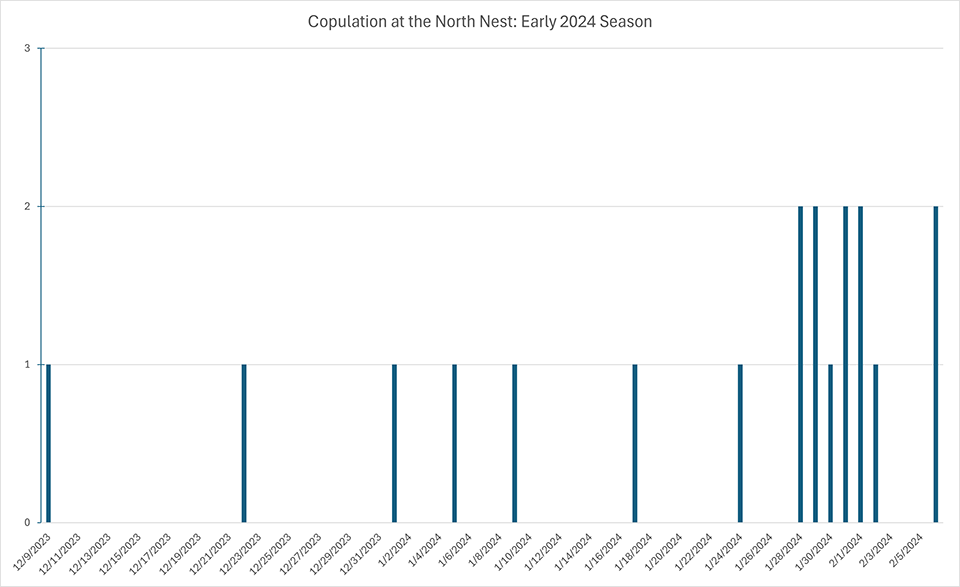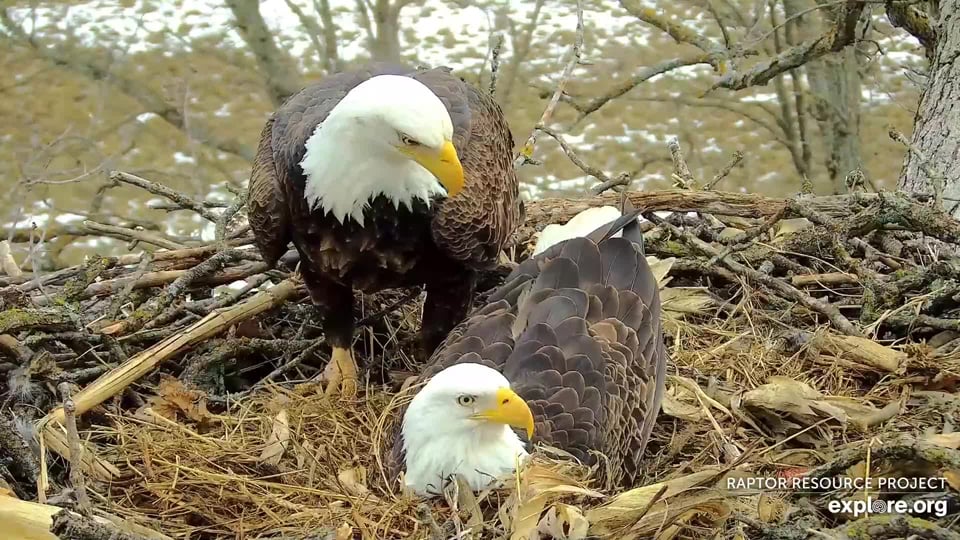Love is in the nest! We are guesstimating that DNF will lay her first egg on or before February 16. If her egg is going to be fertilized, the two need to copulate a lot. What does bonding look like so far?
 February 2, 2024: Copulation at the North Nest, early 2024 season. Looking good, Mr. North and DNF!
February 2, 2024: Copulation at the North Nest, early 2024 season. Looking good, Mr. North and DNF!
Mr. North and DNF first copulated on December 9, but bonding frequency really didn’t ramp up until January 28th! What flipped the switch? Lengthening days, swelling gonads, and hormones: a topic we cover here. This is an eggcellent sign for those of us whose egg clocks are ticking!
Bald eagle courtship
Bald eagles are famous for their whirling nuptial flight, but eagle courtship includes any activities that establish a new pair bond or renew an existing one. At our Decorah, Decorah North, and Xcel Energy Fort St. Vrain nests, courtship usually begins in early October. Bonded pairs start working on their nests by bringing in sticks, large branches, and soft materials to replenish and rebuild them.
As courtship deepens in December and January, eagles ramp up their nestwork, burying last year’s nestorations under piles of new sticks and heaps of corn husks, corn stalks, and fluffy grass. Male eagles bring food gifts to their mates, eagle couples perch and vocalize together, and eagles prepare their nest bowls for eggs by digging, scraping, and molding multiple layers of soft stuff to the nest’s floor. They move from working and perching together to pecking, footing, body brushing, and displaying as they signal their growing interest in bonding.
Copulation
Male eagles, like most male birds, lack an external phallus. Eagle mating goes something like this. An eagle (usually but not always the male) approaches its partner, vocalizing, swishing its tail, and leaning into or looming over its object of desire. An uninterested female (not now, dear!) might respond by standing up and starting what looks like a breast-bumping competition. An amorous female tilts forward, allowing her mate to land with his curled feet lodged on her back. She twists and moves her tail feathers to one side so he can press and twist his cloacal opening around her cloaca, passing sperm from his cloaca to hers. Intense, rapid vocalizations often precede and accompany mating, which takes seven to twelve seconds.
Female eagles also approach and mount their mates, letting them know in no uncertain terms that they are receptive and ready for copulation. This behavior varies widely from nest to nest and eagle to eagle. Mom Decorah took the lead on a fairly regular basis, but it’s rare for Ma FSV to do so. HD needed a lot of encouragement from HM last year, but they were new mates. And at Decorah North this year, we saw DNF take the lead when Mr. North didn’t respond to her overtures.
Why are nestorations part of bonding?
Why are nestorations part of bonding? It goes something like this: birds that build awesome nests relative to other members of their species must be healthy, high-quality mates. Think about bald eagles! As we’ve seen at all of our nests, eagles spend a lot of time procuring and hauling wood and soft materials into the nest. This is an energetically costly activity that requires them to be in good shape: well-fed, skilled at flying, and relatively parasite-free. While different things indicate quality to different species of birds, large nests appear to signify quality to bald eagles.
 January 30, 2024: Mr. North tests the nest. Is the fit just right?
January 30, 2024: Mr. North tests the nest. Is the fit just right?
Both bald eagle parents build and maintain their nest, but males tend to spend more time getting sticks just right, preparing the nest bowl, and building the egg cup. What’s going on? Many female birds adjust their reproductive efforts in relation to their mate’s nest-building activities. The more time he spends working on the nest, the more time and energy she puts toward reproductive processes, including copulation. The end result? A higher chance of reproductive success for both of them!
Bald eagle mating – not as straightforward as we once thought!
Why do some male eagles seem timid? Why do some couples bond more often than others? Mr. North and DNF bonded frequently in their first year together, DM2 needed a lot of encouragement to approach Mom, HD also seemed a little timid – and the FSV eagles seem to enjoy bonding in their nest instead of perched on a branch! Sex, age, relationship status, and eagle personalities all influence bonding behavior. Look for them at every nest you watch!
We know a lot more about eagle bonding than we did back in 2011! At the time, people believed that eagles didn’t bond very often outside their fertile periods. While female eagles were receptive to bonding, they seldom initiated it and always assumed a submissive role during copulation. But bird cams revealed a whole new world! Couples bond well outside their egg-laying period, although bonding becomes more frequent and intense when eagles are at or near peak fertility. Both male and female eagles initiate bonding and either one may assume a dominant role during copulation. Territorial eagle couples are usually monogamous and are not known to participate in extra-pair bonding, but mating systems can include thruples instead of couples. Pair bonds are often established at a nest or territory, but can also be established on wintering grounds prior to a couple’s first nesting. Whatever an eagle’s inner landscape looks like, their pair behaviors are richer and more complex than we once believed. The more we learn, the more questions we have!
A huge thanks to our camera operators for providing copulation data! I know the video of HM and HD is older, but it provides such an excellent look at Bald Eagle mating that I wanted to include it. It also remains the cutest eagle copulation video I’ve ever seen.
 The Raptor Resource Project
The Raptor Resource Project The Raptor Resource Project
The Raptor Resource Project